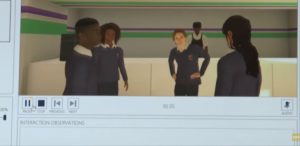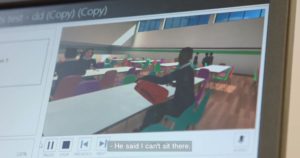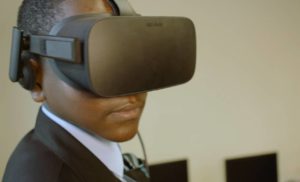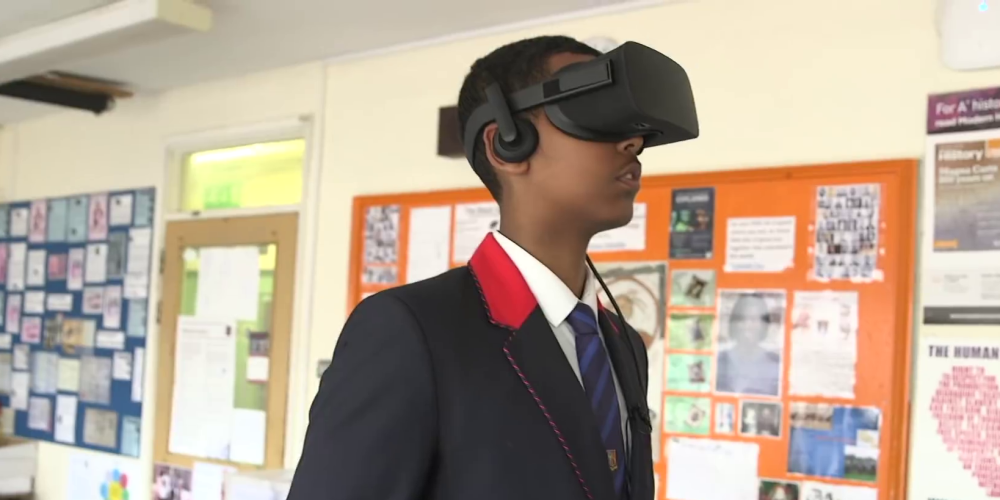AIXR VRAwards 2019 ‘VR Healthcare of the Year’ finalist
VR for Psychosis Research and Treatment: Using VR for Understanding Risk factors for Paranoid Ideation in Young People
Short description
The project is an application that simulates a school canteen in a VR environment for young people between 14 and 16 years old.
The VR experience contains different ambiguous social situations that may trigger paranoid ideation in adolescents when using it. By doing so, the therapist can assess the degree to which individuals experience paranoid ideation to these situations.
The application was developed for Belgian adolescents, complementing the first trial deployed in the UK 2 years ago.
Aim of the project
The project will allow the scientific community to more thoroughly understand how adverse experiences may be implicated in the development of unwarranted paranoid beliefs by using a VR environment, and importantly what protective factors may help to mitigate these effects thus illuminating key elements for prevention and intervention for adolescents who are at risk of developing more severe mental health problems.
The expected outcome is to address the following questions:
- As a basis for providing more robust estimates of prevalence of state paranoia, what is the extent of agreement between questionnaire, interview, and VR rated paranoid ideation?
- Which environmental risk factors are prospectively associated with increased occurrence and persistence over time of paranoid ideation?
- What individual, familial, and community level factors mitigate (reduce) the impact of particular risk factors on paranoid ideation among adolescents?
Project release date
April 2019
Platform
Oculus Rift
What sets the project
The uniqueness of the project is the ability to asses, for the first time, paranoid ideation in adolescents.
In adults, immersive virtual reality (VR) has emerged as a novel way to reliably measure the occurrence of paranoia in social situations. Building on this line of research, and using the age-appropriate canteen application developed by Virtualware, King’s College is able to assess paranoid ideation in adolescents.
Given the immersive nature of VR, it leads to the same cognitive, emotional, behavioural, and physiological responses that are triggered in real life situations. With the use of VR, researchers can therefore expose individuals to the same social environment and explore their individual response. Previous VR research has shown that in young adults, the same social cue, ‘someone looking at you and then looking away’, can be interpreted as threatening “they don’t like me”, as positive ”they were checking me out because they like me”, or as neutral “they looked up because I was approaching”.
The application, therefore, provides an indication of the degree to which adolescents experience paranoid ideation to ambiguous social situations. Digital technology can revolutionise how we identify, assess, treat, and research, mental health in young people. This is a vitally important arena given that around 75% of all adult mental health problems begin before the age of 18 years old; adolescence is a window of opportunity to have a massive impact on rates of mental health problems by intervening to prevent people from developing what are lasting problems.

The project is aimed at
The target demographics for the project are young people between 14 and 16 years old.
The reason behind this choice is given by the fact that around 75% of all adult mental health problems begin before the age of 18 years old.
Using VR within a sample of adolescents, the proposed project is the first study to thoroughly investigate risk and protective factors for unwarranted paranoid thoughts towards others. Crucially, the first trial of the project was nested in the REACH study (Resilience and Ethnicity in AdolesCent mental Health), a unique longitudinal study based in south London which is collecting data on over 4000 adolescents at three time points.
Now, the project is being replicated in Belgium, reason why Virtualware has adapted the application for the Belgian adolescents.
Statement
As head mounted displays become popular and affordable, enthusiasm is growing among clinicians and researchers around the world about the potential that Virtual Reality offers to improve the assessment and treatment of mental problems.
This project demonstrates the potential of virtual reality for research, assessment and treatment of mental illnesses by enabling researchers and clinicians to bring real-time life experiences into a lab environment.

Traditionally, the assessment of clinically relevant phenomena – such as neurocognitive processes, emotional reactions, physiological activation or behavioural responses – involved standardised questionnaires, semi-structured interviews about symptoms, doing computer tasks, watching videos or images, or role playing a situation while the physiological response was measured. Although the reliability and validity of these methods have been tested extensively, they lack ecological validity and do not represent the complexity of real-life experiences.
Virtualware and King’s College show the innovative potential of Virtual Reality, allowing to measure real-time cognitive, emotional, physiological and behavioural responses in a simulated “real-life” situation, while enabling experimental control.
The results of the projects indicate that Virtual Reality assisted therapy can be a powerful tool to help adolescents break the cycle of avoidance involved in the maintenance of paranoid ideation and develop new skills and strategies to couple with them.
Moreover, the project lays the foundation for further research workstreams. On one hand, it is interesting to investigate the use of virtual reality the in training of mental health staff to improve their skills in recognizing and treating mental diseases. Virtual Reality could also play a crucial role in researching resilience factors to stressful events in relation to different mental disorders and could inform the development and implementation of prevention strategies.

On the other hand, there is an opportunity to achieve a multi-disciplinary understanding of the mechanisms involved in the onset and maintenance of mental diseases that draw connections between psychology, psychiatry, neuroscience, education computer science and gaming technology. This workstream could find answers to the following questions: How do mental diseases affect behaviour in social situations? How can social environments be effective in building resilience and improving wellbeing of young people at ultra-high risk for psychosis? How can we use Virtual Reality in teaching settings to educate young people about early signs of mental health problems?
To achieve these goals, there is a need to break down the invisible barriers between academia, healthcare providers and new technology industry. Virtualware and King’s College set a precedent of such a partnership.
Impact of the project
The results from the London-based first trial demonstrated that people’s interaction in the VR environment shows their potential mental health problems.
As an example, there’s on interaction where a boy is sitting at a table with a bag, and as the user approaches the boy, he puts the bag on a seat and says, “you can’t sit here, I’m waiting for someone”. Some young people will perceive that interaction as a threat and will feel they are disliked by that person. This situation helps adolescents to safely practice how they would respond in a real situation. On top of that, adolescents found the approach unthreatening and enjoyable.

STATUS: Virtualware


